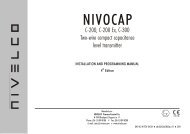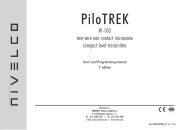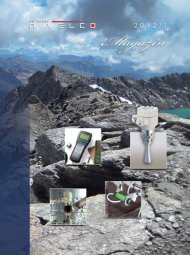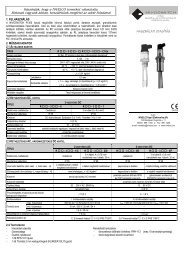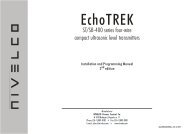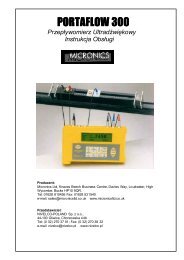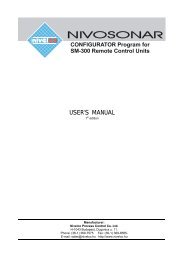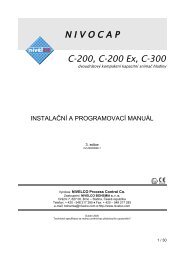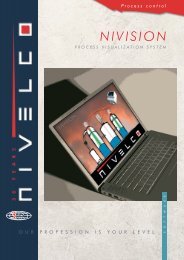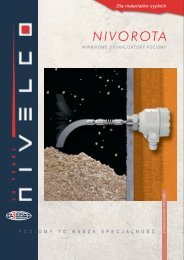Download - Nivelco Process Control Co., Inc.
Download - Nivelco Process Control Co., Inc.
Download - Nivelco Process Control Co., Inc.
You also want an ePaper? Increase the reach of your titles
YUMPU automatically turns print PDFs into web optimized ePapers that Google loves.
Approvals and certifications of the Instrument IndustryIn Hungary there are nearly 30 Notified Bodies, in caseof many directives we can choose between three Institutes,but there are some special areas when we have to turn toforeign Certification Institutes. The European <strong>Co</strong>mmitteeappoints the Notified Body as the administration body inmost of the cases of any Directives.With all directives, it is also true that these contain only“guidelines”, which are considered mandatory. The detailedprocedures are described in the local (national) laws.It is possible that the law is a straight translation of theoriginal directive, but for example the “9/2001. (IV. 5.)GM” regulation for pressure equipped devices is a combinedregulation consisting of the elements of two(different directives 87/404/EEC and 97/23/EC).What does an evaluation of the conformity look like,and what does the type-approval mean? The differentdirectives usually provide 8 optional procedures (examinationmodules) to test the product conformance.These modules cover different methods and combinationsfrom unique product examination to manufacturing ordocumentation of quality-control tests. In case of higher riskcategory products only certain modules can be chosen.The obvious choice for mass-produced types is the multistageexamination. At the first stage is a so-called NotifiedBody, (chosen by the European <strong>Co</strong>mmittee) which performsa careful design-test according to the manufacturer'sdesign documentation, then examines one (or more)finished products. If the examination results in the documentsand the product (mostly a destructive test methodis used for product tests) both meeting the requirementsof the current standards, then the production related qualitycontrol system gets under verification. During this procedurethe manufacturer has to show his systems are ableto provide the required quality independently from the volumeof the manufactured products.<strong>Co</strong>nsidering thatconformity of a productis fully guaranteedby themanufacturers accordingto the abovementioned Declarationof <strong>Co</strong>nformity,the accredited notified bodies only take a role as an accessoryplayer and the responsibility remains with the manufacturer.It is clearly visible now, that clever solutionsare not enough to obtain a type-approval.Manufacturers have to implement the requirements of thecurrent standards and regulations and these proceduresshould be approved by a third-party Notified Body.This is a riskier process than the realisation of a successfulproject, consuming more time, money and energy –therefore it represents undoubtedly greater marketingpower.The oldest and still the most commonly used safety requirementis the safety of equipment in hazardous explosiveatmospheres. The history of this requirement is as old asmining itself. At first it contained technical solutions almostexclusively in order to avoid firedamp explosions.Unfortunately, as with all safety standards: catastropheshappen first, then safety regulations come seeking toprevent these catastrophes as a next step. Exactly the samehappened in the city of Minneapolis, Minnesota, USA, in1878 when the biggest corn mill in the world exploded.The explosion at the Washburn <strong>Co</strong>mpany’s mill killed 18workers and destroyed the neighbouring houses, razingthem to the ground. The reason was a simple spark, ignitingthe dust in the air (full of electrostatically chargedpowder), which was enough to blow apart the enormousconcrete-monster. However nobody was surprised at thispreviously unknown phenomenon, and suitable safety regulations(related mostly to airing) came into effect onlyin 1880 at similar factories.21




